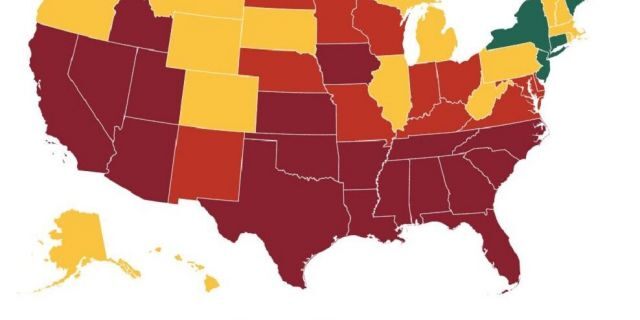[ad_1]
A new map highlighting the spread of the coronavirus shows more than half of all states “trending poorly” or facing an “uncontrolled spread” as COVID-19 continues to make a resurgence in the United States.
Created by covidexitstrategy.org, the map tracks each state’s coronavirus response based on a set of criteria provided by the White House that specifies what each state and region must accomplish before moving forward with plans to reopening their economies.
The map measures and scores each state based on the number of positive cases over a 14-day period using a 7-day rolling average, bed capacity at hospitals and intensive care units and positivity rates.

A map created by health experts tracks each state response to the coronavirus based on criteria set by the White House.
(covidexitstrategy.org)
According to the figure, New York, once the epicenter of the virus, is trending for the better while nearly all Southern and some Midwestern states are faring far worse. New York recorded a 1 percent positivity rate over the past 14 days, following weeks of lockdown measures.
California is listed with an “uncontrolled spread” with 219 cases per every million people. The state has seen significant gains erased as infections continue to climb, forcing Gov. Gavin Newsom re-impose restrictions and business closures.
Texas, Florida and Georgia are also seeing giant upticks in COVID-19 cases. Texas and Florida engaged in some of the most aggressive reopenings among states and have since enacted restriction measures to combat the disease’s spread.
Florida recorded a nearly 19 percent positivity rate, up from 15.6 percent two weeks ago.
CLICK HERE TO GET THE FOX NEWS APP
The only states trending for the better are New York, Massachusetts, Maine — with a .0 percent positivity rate — and New Jersey. Around 16 states, including Pennslyvania, Illinois and Washington, are in limbo with caution being warranted if the number of cases increases.
As of Monday night, the U.S. reported more than 3.3 million confirmed COVID-19 cases and over 135,000 deaths, according to Johns Hopkins University. The map was created by a non-partisan group with experts from the White House, U.S. Department of Health and Human Service and on the Ebola epidemic in West Africa.
[ad_2]
Source link

